Tsoulfanidis N. Measurement and detection of radiation
Подождите немного. Документ загружается.


328
MEASUREMENT
AND
DETECTION OF RADIATION
n
RC
circuits
Figure
10.16 The output pulse after using many shaping circuits. The triangle indicates the
amplification unit that isolates any two consecutive shaping circuits.
10.7
TIMING
The term
timing
refers to the determination of the time of arrival of a pulse.
Timing experiments are used in measurement of the time development of an
event (e.g., measurement of the decay of a radioactive species), measurement of
true coincident events out of a large group of events, and discrimination of
different types of particles based on the different time characteristics of their
pulse (pulse-shape discrimination).
Timing methods are characterized as "slow" or "fast" depending on the way
the signal is derived. Slow timing signals are generated by an integral discrimina-
tor or a timing single-channel analyzer. In either case, timing is obtained by
using a shaped signal at the output of an amplifier. Fast timing signals are based
on the unshaped pulse at the output of the detector or on a signal shaped
specifically for timing.
Many timing methods have been developed over the years. All the methods
pick
the time based on a certain point in the "time development" of the pulse,
Figure
10.17
A
doubly differentiated pulse.
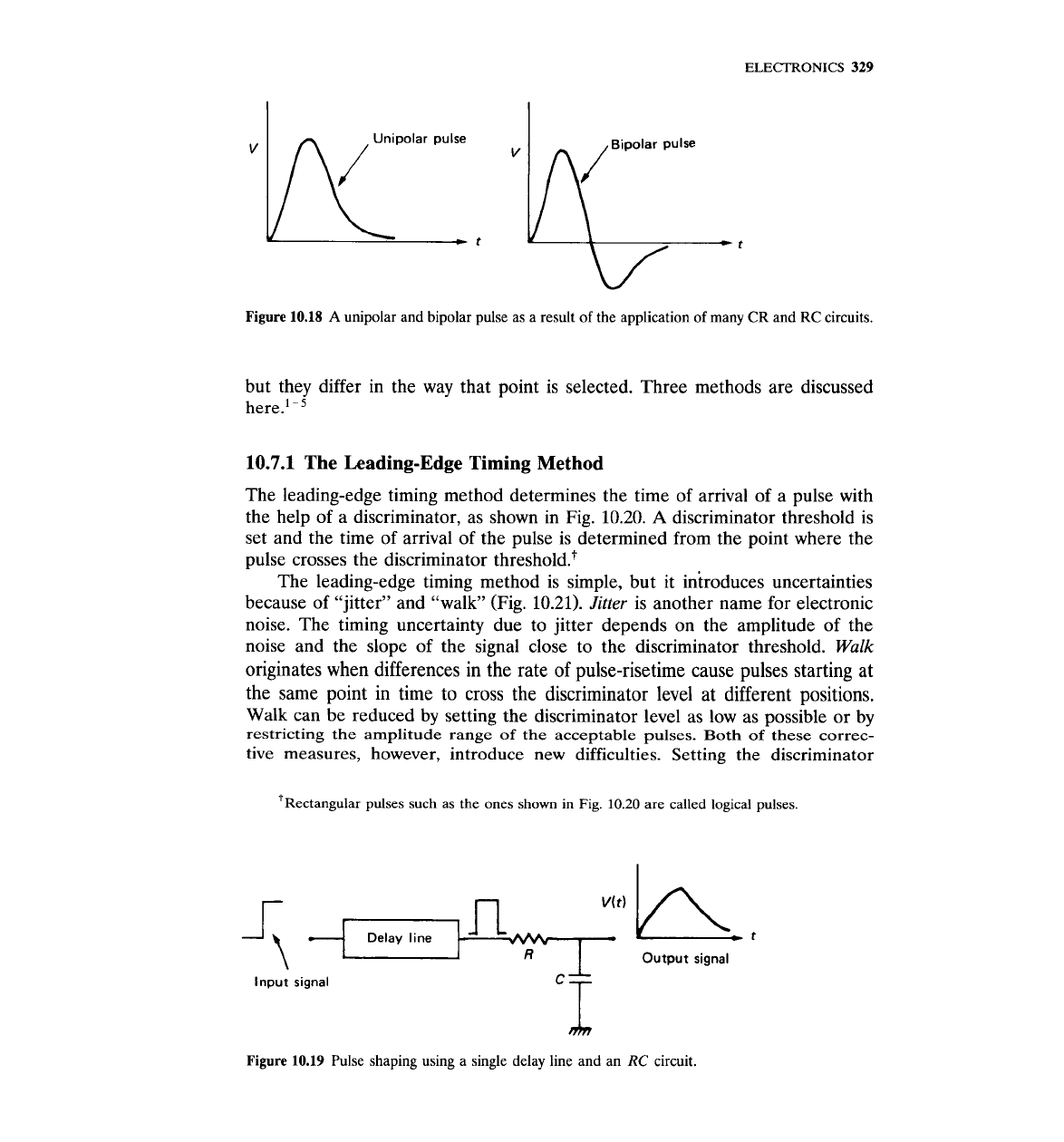
ELECTRONICS
329
polar
pulse
\
/
v
+
t
Figure 10.18
A
unipolar and bipolar pulse as a result of the application of many CR and RC circuits.
but they differ in the way that point is selected. Three methods are discussed
here.'
-'
10.7.1
The Leading-Edge Timing Method
The leading-edge timing method determines the time of arrival of a pulse with
the help of a discriminator, as shown in Fig. 10.20.
A
discriminator threshold is
set and the time of arrival of the pulse is determined from the point where the
pulse crosses the discriminator threshold.+
The leading-edge timing method is simple, but it introduces uncertainties
because of "jitter" and "walk (Fig. 10.21).
Jitter
is another name for electronic
noise. The timing uncertainty due to jitter depends on the amplitude of the
noise and the slope of the signal close to the discriminator threshold.
Walk
originates when differences in the rate of pulse-risetime cause pulses starting at
the same point in time to cross the discriminator level at different positions.
Walk can be reduced by setting the discriminator level as low as possible or by
restricting the amplitude range of
the
acceptable pulses.
Both
of these correc-
tive measures, however, introduce new difficulties. Setting the discriminator
t~ectangular pulses such as the ones shown
in
Fig.
10.20
are called logical pulses.
Delay line
t
Output
signal
Input signal
'T
nm
Figure 10.19
Pulse shaping using a single delay line and an
RC
circuit.
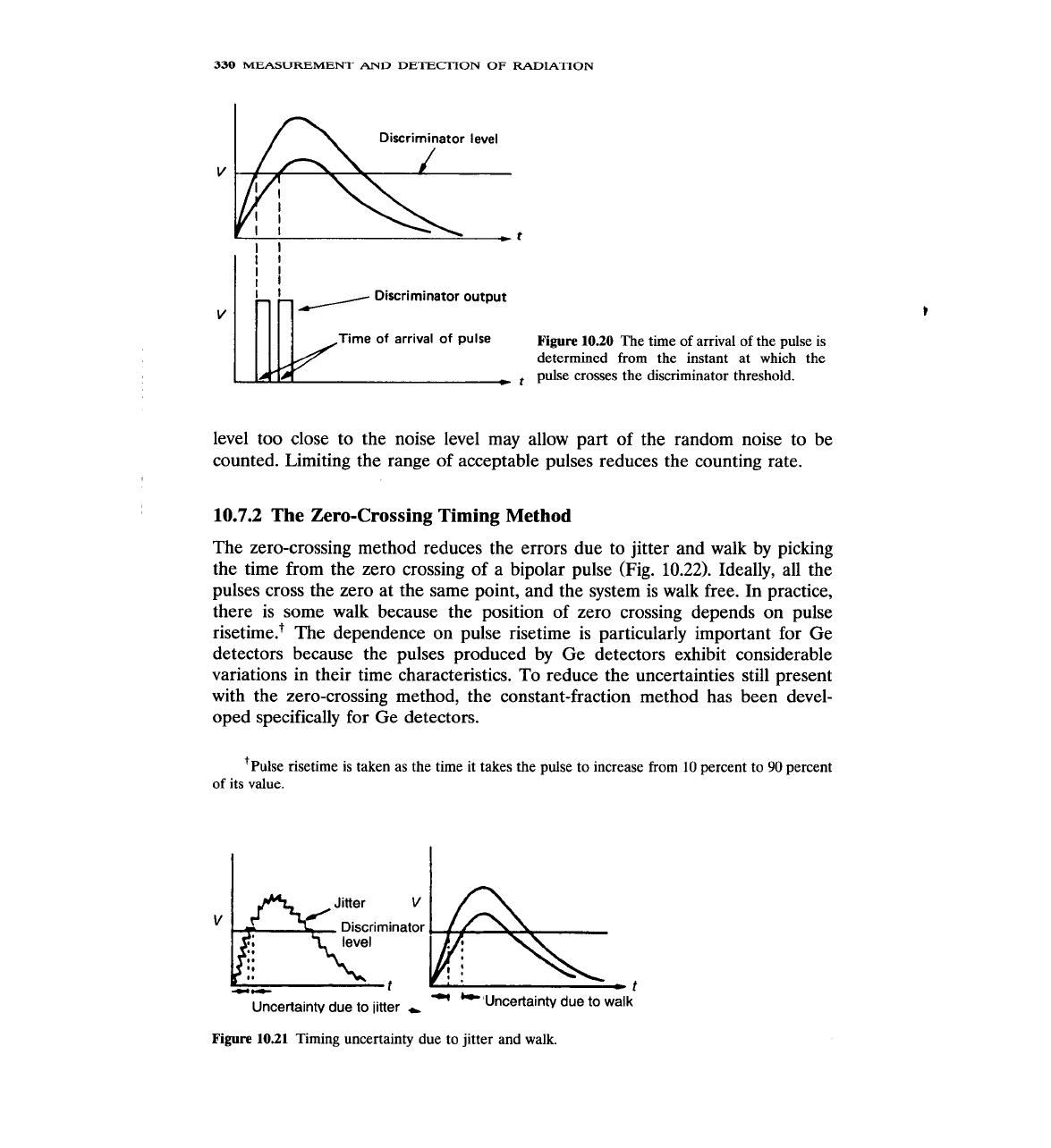
330
MEASUREMENT
AND
DETECTION
OF
RADIATION
Discriminator output
Time
of
arrival
of
pulse
Figure
10.20
The time of arrival of the pulse is
determined from the instant at which the
pulse crosses the discriminator threshold.
level too close to the noise level may allow part of the random noise to be
counted. Limiting the range of acceptable pulses reduces the counting rate.
10.7.2
The Zero-Crossing Timing Method
The zero-crossing method reduces the errors due to jitter and walk by picking
the time from the zero crossing of a bipolar pulse (Fig.
10.22).
Ideally, all the
pulses cross the zero at the same point, and the system is walk free.
In
practice,
there is some walk because the position of zero crossing depends on pulse
risetime.+ The dependence on pulse risetime is particularly important for Ge
detectors because the pulses produced by Ge detectors exhibit considerable
variations in their time characteristics. To reduce the uncertainties still present
with the zero-crossing method, the constant-fraction method has been devel-
oped specifically for Ge detectors.
'Pulse risetime is taken as the time it takes the pulse to increase from
10
percent to
90
percent
of its value.
Jitter
Discriminator
level
4-
Uncertainty due
to
jitter
buncertainty due to walk
Figure
10.21
Timing uncertainty due to jitter and walk.
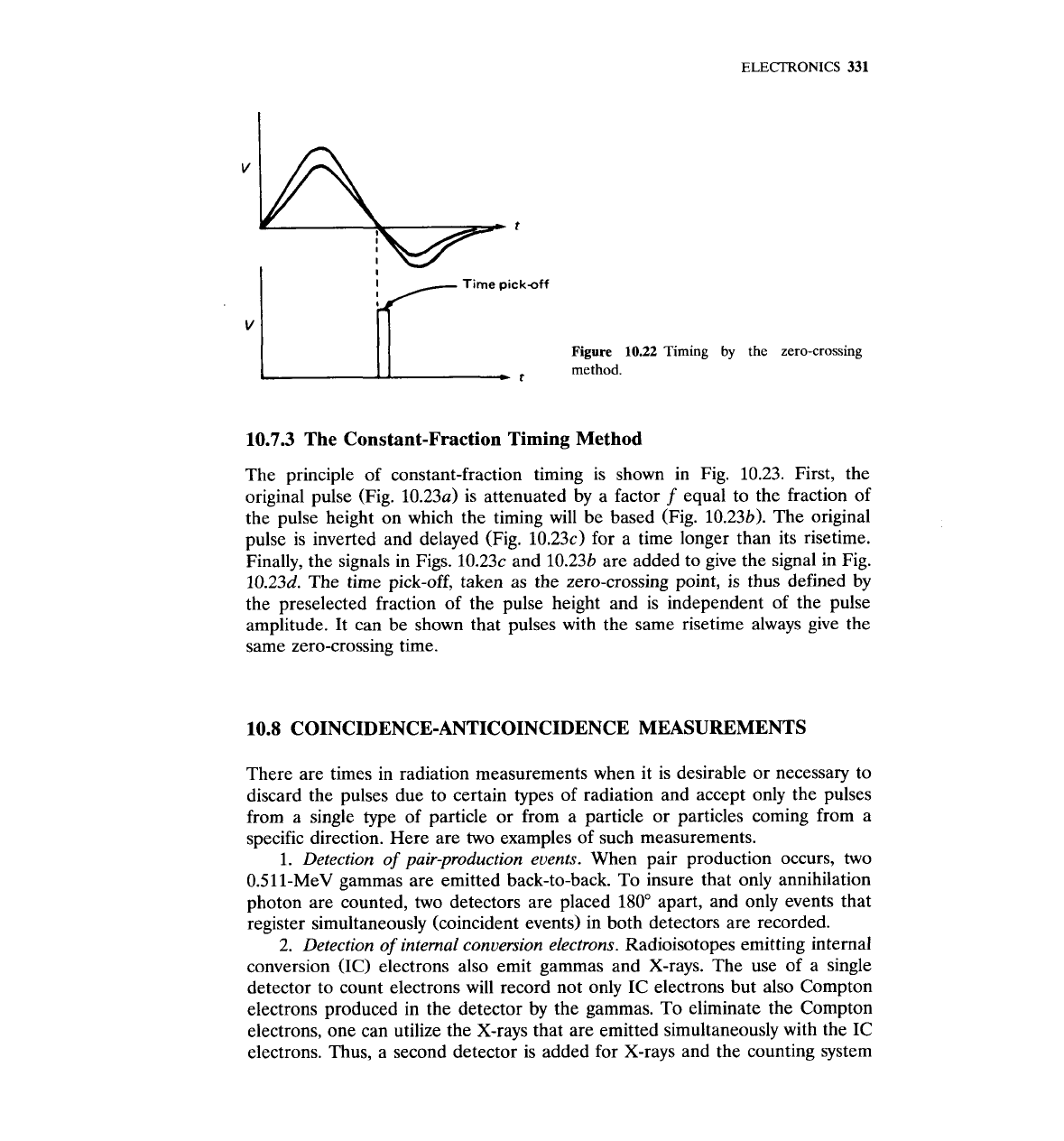
I(
Time
pickaff
Figure
10.22
Timing
by
the zero-crossing
method.
10.7.3 The Constant-Fraction Timing Method
The principle of constant-fraction timing is shown in Fig. 10.23. First, the
original pulse (Fig. 10.23a) is attenuated by a factor
f
equal to the fraction of
the pulse height on which the timing will be based (Fig. 10.23b). The original
pulse is inverted and delayed (Fig. 10.23~) for a time longer than its risetime.
Finally, the signals in Figs. 10.23~ and 10.23b are added to give the signal in Fig.
10.23d. The time pick-off, taken as the zero-crossing point, is thus defined by
the preselected fraction of the pulse height and is independent of the pulse
amplitude. It can be shown that pulses with the same risetime always give the
same zero-crossing time.
10.8 COINCIDENCE-ANTICOINCIDENCE MEASUREMENTS
There are times in radiation measurements when it is desirable or necessary to
discard the pulses due to certain types of radiation and accept only the pulses
from a single type of particle or from a particle or particles coming from a
specific direction. Here are two examples of such measurements.
1. Detection of pair-production events. When pair production occurs, two
0.511-MeV gammas are emitted back-to-back. To insure that only annihilation
photon are counted, two detectors are placed
180"
apart, and only events that
register simultaneously (coincident events) in both detectors are recorded.
2. Detection of internal conversion electrons. Radioisotopes emitting internal
conversion
(IC)
electrons also emit gammas and X-rays. The use of a single
detector to count electrons will record not only IC electrons but also Compton
electrons produced in the detector by the gammas. To eliminate the Compton
electrons, one can utilize the X-rays that are emitted simultaneously with the IC
electrons. Thus, a second detector is added for X-rays and the counting system
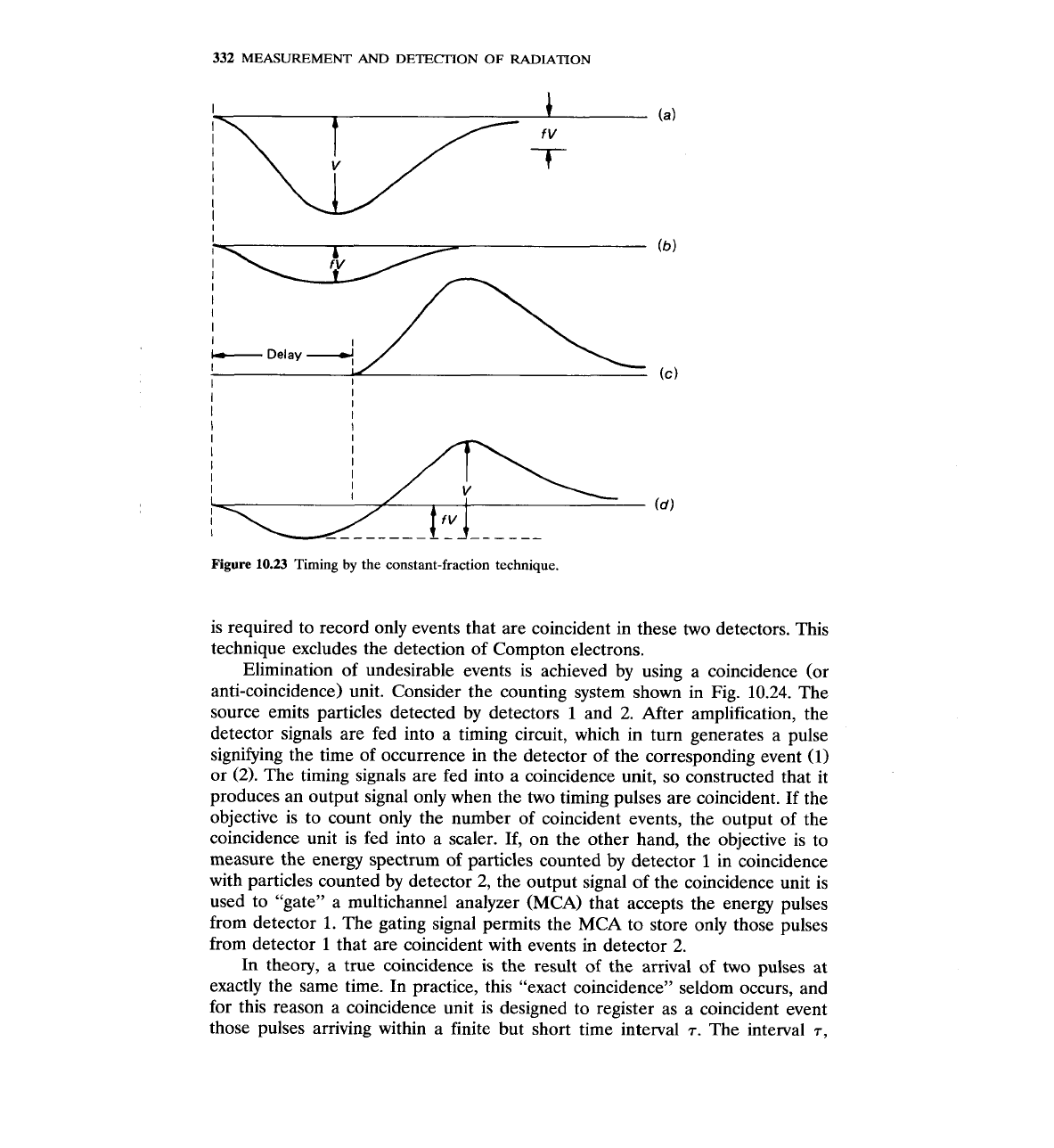
332
MEASUREMENT
AND
DETECTION OF RADIATION
Figure
10.23
Timing
by
the constant-fraction technique.
is required to record only events that are coincident in these two detectors. This
technique excludes the detection of Compton electrons.
Elimination of undesirable events is achieved by using a coincidence (or
anti-coincidence) unit. Consider the counting system shown in Fig. 10.24. The
source emits particles detected by detectors
1
and 2. After amplification, the
detector signals are fed into a timing circuit, which in turn generates a pulse
signifying the time of occurrence in the detector of the corresponding event (1)
or
(2).
The timing signals are fed into a coincidence unit, so constructed that it
produces an output signal only when the two timing pulses are coincident. If the
objective is to count only the number of coincident events, the output of the
coincidence unit is fed into a scaler. If, on the other hand, the objective is to
measure the energy spectrum of particles counted by detector
1
in coincidence
with particles counted by detector 2, the output signal of the coincidence unit is
used to "gate" a multichannel analyzer (MCA) that accepts the energy pulses
from detector
1.
The gating signal permits the MCA to store only those pulses
from detector
1
that are coincident with events in detector
2.
In theory, a true coincidence
is
the result of the arrival of two pulses at
exactly the same time. In practice, this "exact coincidence" seldom occurs, and
for this reason a coincidence unit is designed to register as a coincident event
those pulses arriving within a finite but short time interval
7.
The interval
7,
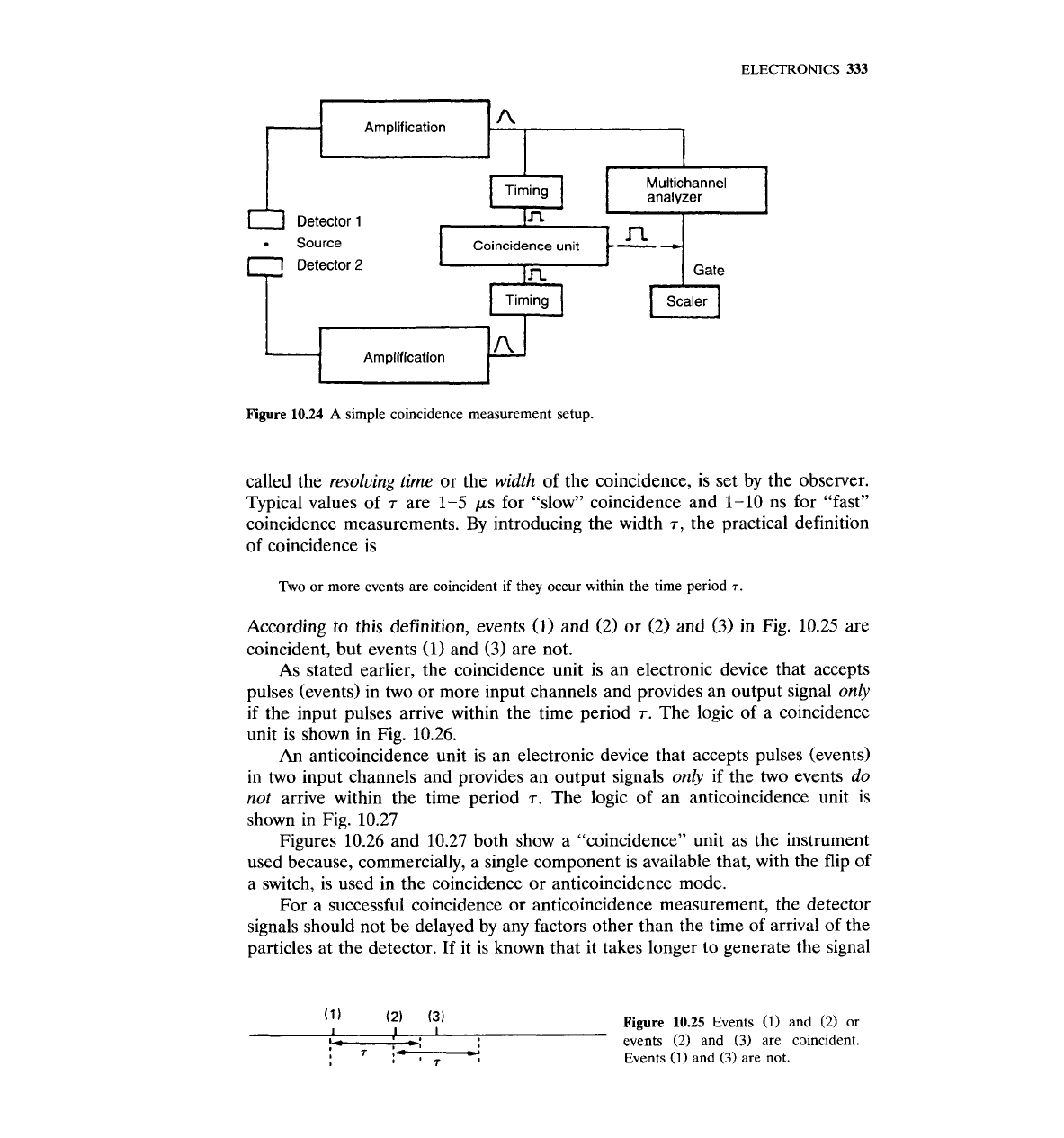
1
Amplification
A
1
Multichannel
Detector
1
Source
I
Coincidence unit
4
Detector
2
I
Figure
10.24
A
simple coincidence measurement setup.
called the
resolving time
or the
width
of the coincidence, is set by the observer.
Typical values of
T
are 1-5 ps for "slow" coincidence and 1-10 ns for "fast"
coincidence measurements.
By
introducing the width
T,
the practical definition
of coincidence is
Two or more events are coincident
if
they occur within the time period
T.
According to this definition, events
(1)
and
(2)
or (2) and
(3)
in Fig. 10.25 are
coincident, but events (1) and
(3)
are not.
As stated earlier, the coincidence unit is an electronic device that accepts
pulses (events) in two or more input channels and provides an output signal
only
if
the input pulses arrive within the time period
T.
The logic of a coincidence
unit is shown in Fig. 10.26.
An
anticoincidence unit is an electronic device that accepts pulses (events)
in two input channels and provides an output signals
only
if the two events
do
not
arrive within the time period
T.
The logic of an anticoincidence unit is
shown in Fig. 10.27
Figures 10.26 and 10.27 both show a "coincidence" unit as the instrument
used because, commercially, a single component is available that, with the flip of
a switch, is used in the coincidence or anticoincidence mode.
For a successful coincidence or anticoincidence measurement, the detector
signals should not be delayed by any factors other than the time of arrival of the
particles at the detector. If it is known that it takes longer to generate the signal
(1)
(2)
(3)
I
Figure 10.25
Events
(1)
and (2) or
I
I
I-
-a
events (2) and
(3)
are coincident.
:
7
!-
Events
(1)
and
(3)
are not.
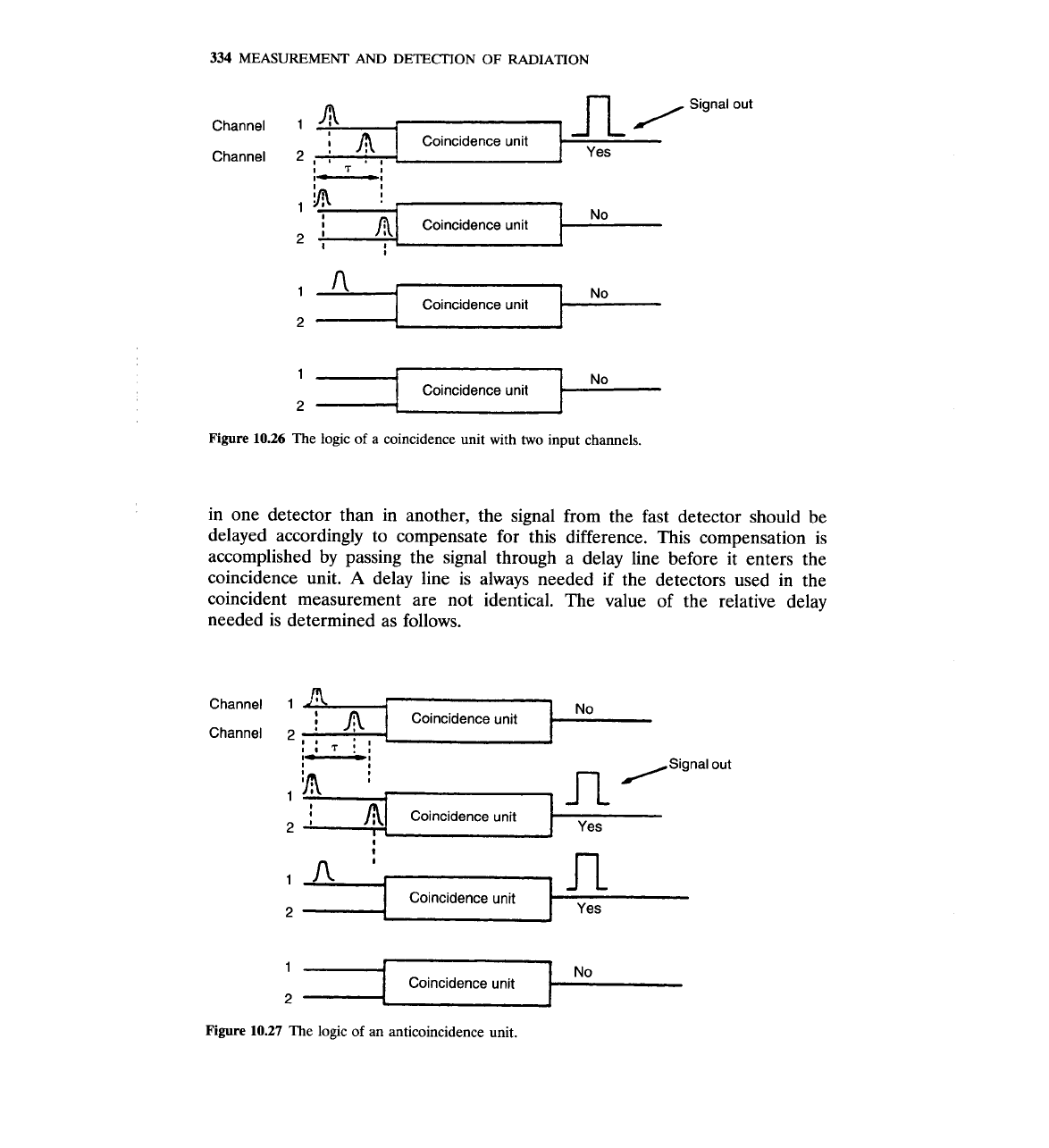
334
MEASUREMENT
AND DETECTION OF RADIATION
Channel
1
Channel
2
Signal out
Yes
17,
No
Coincidence unit
Figure
10.26 The logic of a coincidence unit with two input channels.
in one detector than in another, the signal from the fast detector should be
delayed accordingly to compensate for this difference. This compensation is
accomplished by passing the signal through a delay line before it enters the
coincidence unit.
A
delay line is always needed if the detectors used in the
coincident measurement are not identical. The value of the relative delay
needed is determined as follows.
1
Coincidence unit
3
Yes
1
No
Coincidence unit
2
Figure
10.27 The logic of an anticoincidence unit.
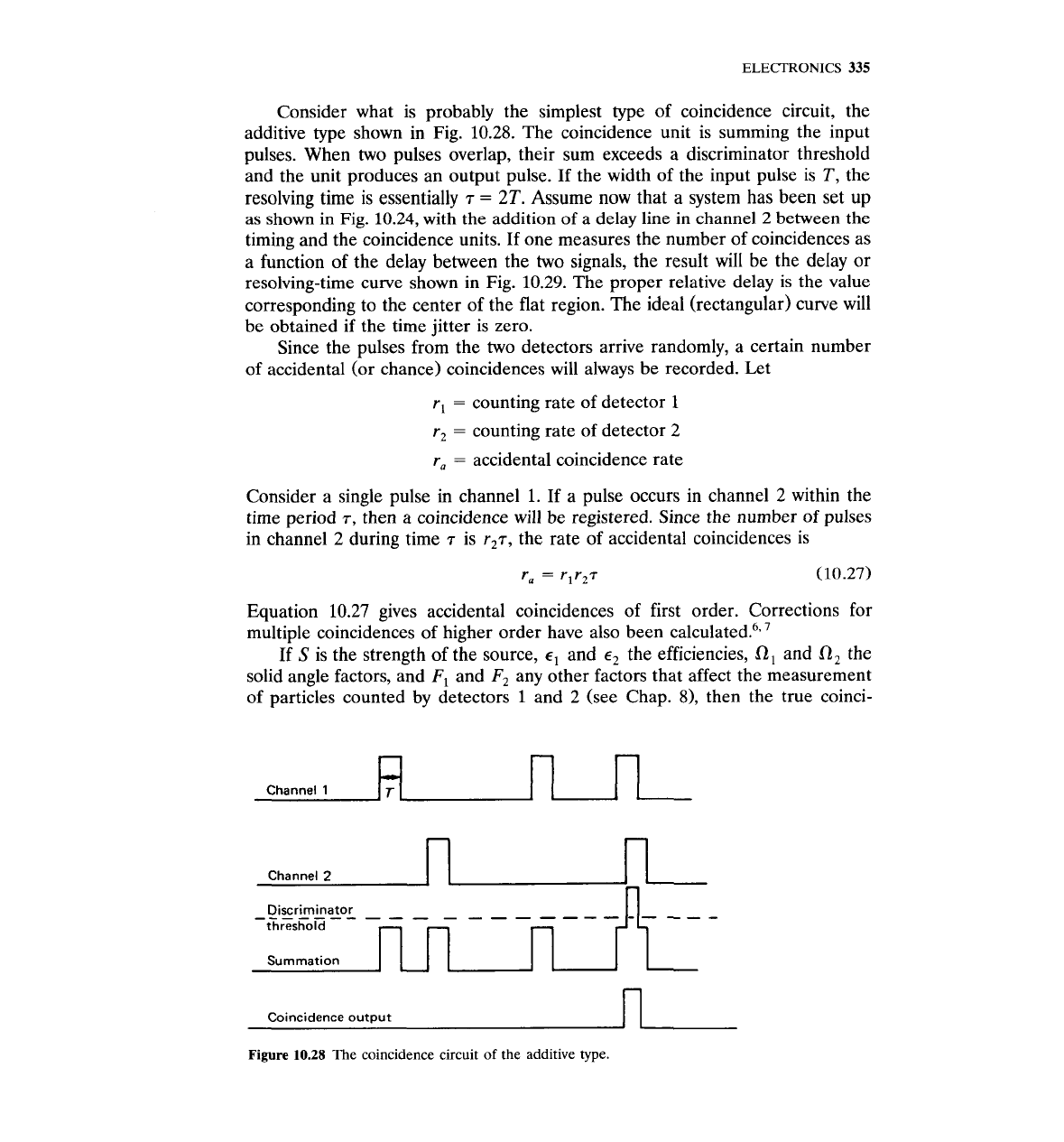
ELECTRONICS
335
Consider what is probably the simplest type of coincidence circuit, the
additive type shown in Fig. 10.28. The coincidence unit is summing the input
pulses. When two pulses overlap, their sum exceeds a discriminator threshold
and the unit produces an output pulse. If the width of the input pulse is
T,
the
resolving time is essentially
r
=
2T.
Assume now that a system has been set
up
as shown in Fig. 10.24, with the addition
of
a delay line in channel 2 between the
timing and the coincidence units. If one measures the number of coincidences as
a function of the delay between the two signals, the result will be the delay or
resolving-time curve shown in Fig. 10.29. The proper relative delay is the value
corresponding to the center of the flat region. The ideal (rectangular) curve will
be obtained if the time jitter is zero.
Since the pulses from the two detectors arrive randomly, a certain number
of accidental (or chance) coincidences will always be recorded. Let
r,
=
counting rate of detector
1
r,
=
counting rate of detector 2
r,
=
accidental coincidence rate
Consider a single pulse in channel 1. If a pulse occurs in channel
2
within the
time period
r,
then a coincidence will be registered. Since the number of pulses
in channel 2 during time
T
is r,r, the rate of accidental coincidences is
Equation 10.27 gives accidental coincidences of first order. Corrections for
multiple coincidences of higher order have also been ~alculated.~.
'
If
S
is the strength of the source,
E,
and
E,
the efficiencies,
0,
and R, the
solid angle factors, and
F,
and
F,
any other factors that affect the measurement
of particles counted by detectors
1
and 2 (see Chap. 8), then the true coinci-
Channel
1
Channel
2
1
(2
I
n
threshold
Summation
Coincidence output
Figure
10.28
The coincidence circuit
of
the additive type.
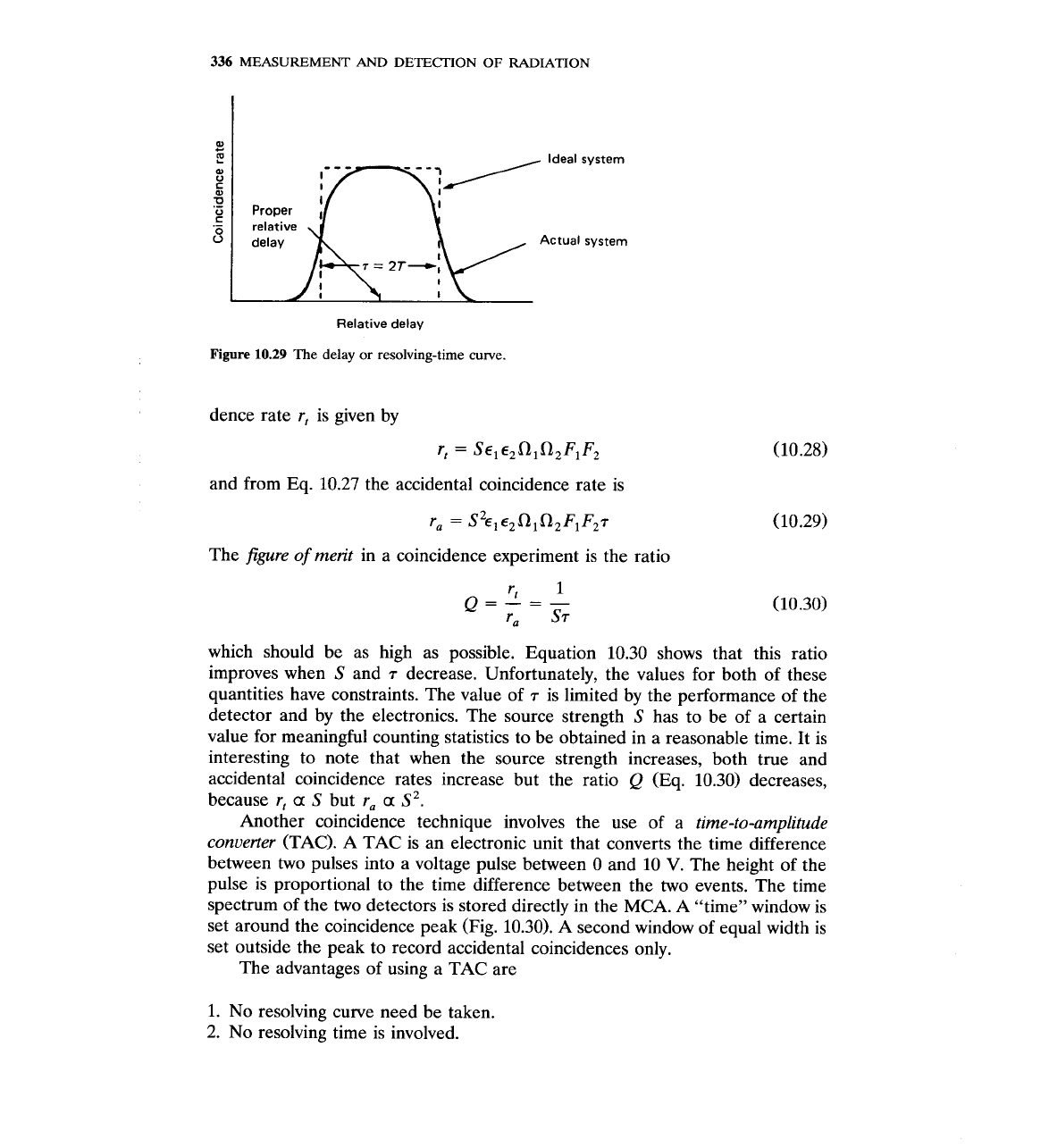
336
MEASUREMENT
AND
DETECTION
OF
RADIATION
m
C
E
m
C
D
o
Proper
.-
relative
delay
Relative delay
Figure
10.29
The delay or resolving-time
curve.
dence rate
r,
is given by
and from Eq. 10.27 the accidental coincidence rate is
The
Jigure of merit
in a coincidence experiment is the ratio
which should be as high as possible. Equation 10.30 shows that this ratio
improves when
S
and
T
decrease. Unfortunately, the values for both of these
quantities have constraints. The value of
T
is limited by the performance of the
detector and by the electronics. The source strength
S
has to be of a certain
value for meaningful counting statistics to be obtained in a reasonable time. It is
interesting to note that when the source strength increases, both true and
accidental coincidence rates increase but the ratio
Q
(Eq. 10.30) decreases,
because
r,
a
S
but
ra
a
S2.
Another coincidence technique involves the use of a
time-to-amplitude
converter
(TAC). A TAC is an electronic unit that converts the time difference
between two pulses into
a
voltage pulse between 0 and 10
V.
The height of the
pulse is proportional to the time difference between the two events. The time
spectrum of the two detectors is stored directly in the MCA. A "time" window is
set around the coincidence peak (Fig. 10.30). A second window of equal width is
set outside the peak to record accidental coincidences only.
The advantages of using a TAC are
1.
No resolving curve need be taken.
2. No resolving time is involved.
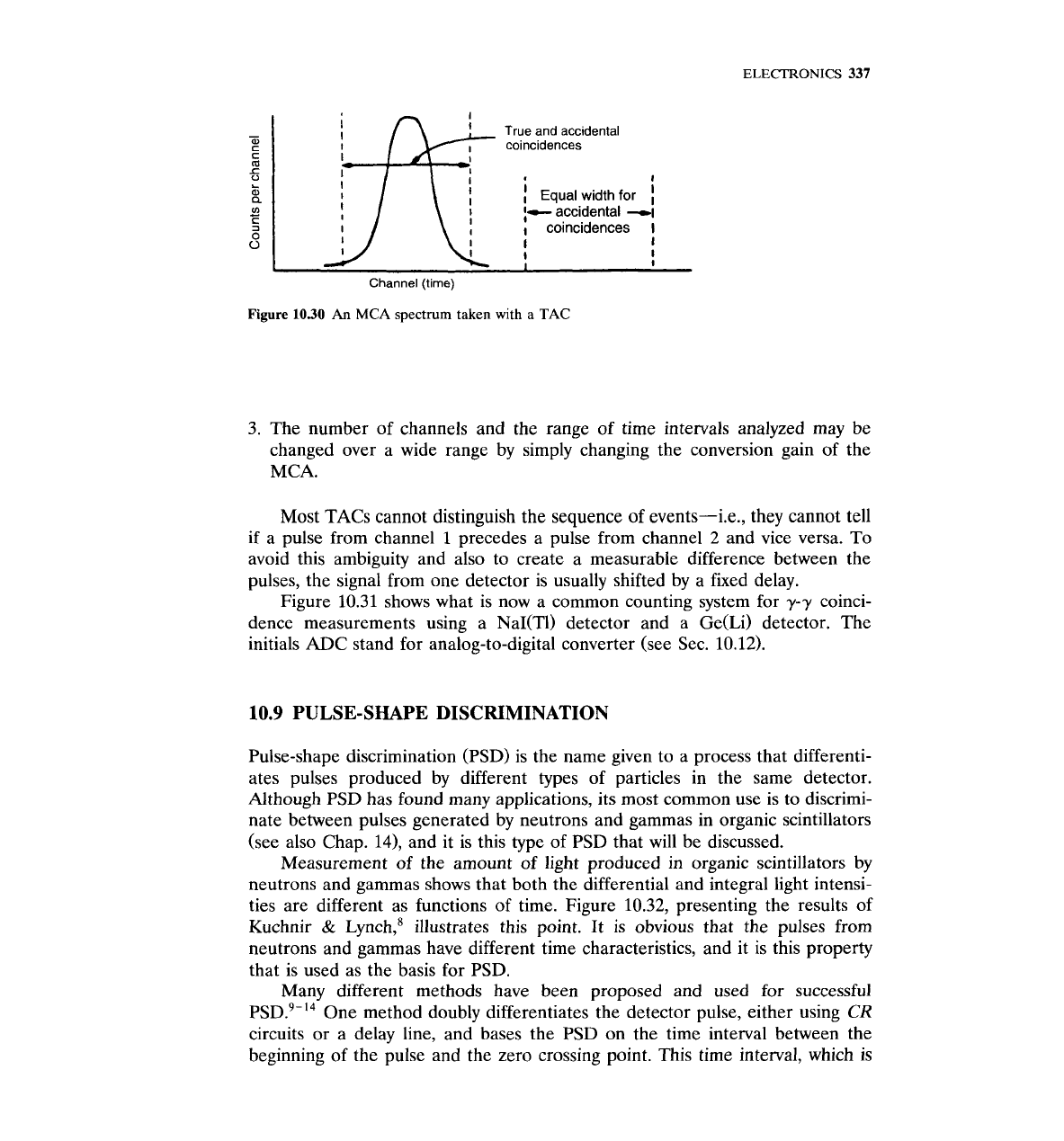
ELECTRONICS
337
/
\!
Equal
width
for
I
I
I
I-
accidental
-1
I
coincidences
I
Channel
(time)
Figure
1030
An
MCA
spectrum taken with a
TAC
3.
The number of channels and the range of time intervals analyzed may be
changed over a wide range by simply changing the conversion gain of the
MCA.
Most TACs cannot distinguish the sequence of events-i.e., they cannot tell
if
a pulse from channel
1
precedes a pulse from channel
2
and vice versa. To
avoid this ambiguity and also to create a measurable difference between the
pulses, the signal from one detector is usually shifted by a fixed delay.
Figure 10.31 shows what is now a common counting system for
y-y
coinci-
dence measurements using a NaI(T1) detector and a Ge(Li) detector. The
initials ADC stand for analog-to-digital converter (see Sec. 10.12).
10.9
PULSE-SHAPE DISCRIMINATION
Pulse-shape discrimination (PSD) is the name given to a process that differenti-
ates pulses produced by different types of particles in the same detector.
Although PSD has found many applications, its most common use is to discrimi-
nate between pulses generated by neutrons and gammas in organic scintillators
(see also Chap.
14), and it is this type of PSD that will be discussed.
Measurement of the amount of light produced in organic scintillators by
neutrons and gammas shows that both the differential and integral light intensi-
ties are different as functions of time. Figure 10.32, presenting the results of
Kuchnir
&
~~nch,' illustrates this point. It is obvious that the pulses from
neutrons and gammas have different time characteristics, and it is this property
that is used as the basis for PSD.
Many different methods have been proposed and used for successful
PSD.~-'~
One method doubly differentiates the detector pulse, either using
CR
circuits or a delay line, and bases the PSD on the time interval between the
beginning of the pulse and the zero crossing point. This time interval, which is
